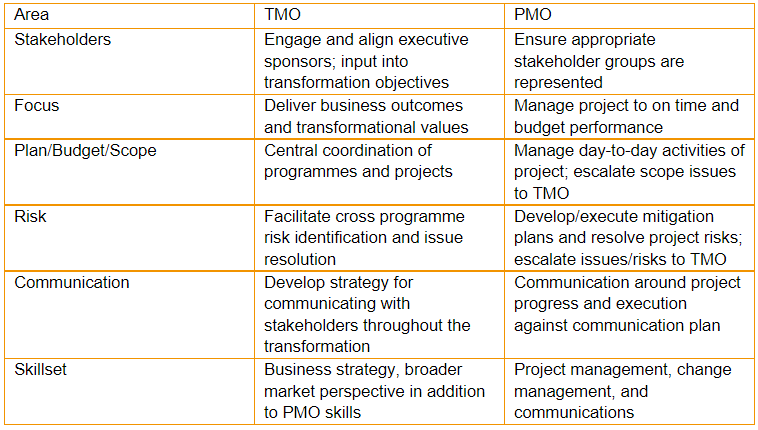What is a TMO and how is it different from a PMO?
To first understand what a Transformation Management Office is, and the role it plays within an organisation, we must first define what we mean by a “transformation”.
McKinsey defined a Transformation as:
“An intense, organisation-wide program to enhance performance (an earnings improvement of 25 percent or more, for example) and to boost organisational health”.
They continue to say that a true Transformation is the way to:
“deliver value, but also to accelerate the metabolic rate of decision making and execution within the company, as the start of a never-ending journey to continued excellence”.
While a PMO is set up to provide support to projects, a TMO is established as an overarching office that is responsible for managing transformation initiatives that involve multiple projects and cross-functional teams. Though it sounds like a Portfolio Management Office, there are some fundamental differences.
TMO Vs PMO
 The TMO will have a higher level of authority as opposed to a PMO. When setting up a TMO, it is recommended that one of the roles assigned is a Chief Transformation Officer (CTO). By having an executive level member within the TMO, decisions and discussions can be had at the highest level within the organisation, and challenges can be made to the status quo.
The TMO will have a higher level of authority as opposed to a PMO. When setting up a TMO, it is recommended that one of the roles assigned is a Chief Transformation Officer (CTO). By having an executive level member within the TMO, decisions and discussions can be had at the highest level within the organisation, and challenges can be made to the status quo.
There are also important organisational differences between a TMO and a PMO. Rather than being responsible for maintaining standards and effective practices within project management, a TMO initiates, defines and implements large-scale transformations across the whole organisation. Therefore, if a project is on a smaller scale that is only affecting one department, then this should be overseen by a PMO. However, if a project is crucial to a new vision, changes the customer experience, affects multiple departments, or changes the business model of the company (think Netflix transforming from a rental DVD company to a video streaming service), then a TMO becomes a must have.
Setting up a TMO
When building a transformation office, there are important stages that need to be established to ensure a robust framework is in place.
1. Align with the Vision
As mentioned above, a TMO differs from a PMO because it is responsible for a large-scale organisational change. Therefore, it is important that the scope of the TMO aligns with the vision of the company, so that the office can champion the transformation within the company and ensure that the ‘new world’ after the transformation is still in the best interests of the company’s core values.
2. Determine reporting structure
Determining the reporting structure of the TMO is important because it will highlight the level of impact and the perception of the office to the organisation. In the best-case scenario, reporting will be provided to a member of the C-suite (via the appointed CTO), and will be embedded within the company structure for the time that it is in operation to ensure maximum impact.
3. Establish Roles and Responsibilities
Ensuring that the right skill sets are in place for the roles within the TMO need to be well established. As the TMO is organisation based, rather than project, a wide variety of strong skillsets need to be included within the office. Programme management, communication, data analytics and core change management skills are all capabilities that need to be included within the TMO. Appointing employees with the strongest skill sets within these areas would help to ensure the TMO is as effective as possible during the transformation.
4. Approach and plan
The TMO will need to capture the current state and the future state of the company, taking into consideration the organisational structure, and how it will look in alignment with the overall vision. Once this has been established, the TMO can then plan how to holistically approach the transformation.
5. Initiate transformation
After a plan has been established and signed off, initiating the transformation can begin. Due to the nature of the TMO, it is recommended that an agile approach is taken, with short regular meetings and reviews to assess and action the next portion of the plan.
A TMO stands as a pivotal force in driving profound organisational change. Its higher authority level, led by a Chief Transformation Officer, empowers it to spearhead transformations that go beyond departmental boundaries, redefining business models. To effectively harness the potential of a TMO, alignment with the company’s vision, clear reporting structures, and the right skill sets are crucial. By adopting an agile approach and tackling transformation with precision, a TMO paves the way for organisations to achieve continuous improvement. If you’re ready to take the next step in your transformation journey, reach out to us today, and make change happen.
Why Choose Us?
Discover why Nine Feet Tall is your top choice for Transformation Management Office (TMO) solutions. With our proven track record and deep expertise in organisational transformation, we specialise in designing tailored TMO frameworks to drive your business forward. Our team works closely with you to understand your unique challenges and objectives, crafting strategies that foster innovation, resilience, and sustainable growth.
By partnering with Nine Feet Tall, you gain access to seasoned professionals who prioritise collaboration, transparency, and delivering tangible results. We provide personalised support every step of the way, ensuring that your TMO initiatives are executed seamlessly and yield transformative outcomes. Choose us to lead your organisation through change and unlock its full potential in today’s dynamic market landscape.
References:




